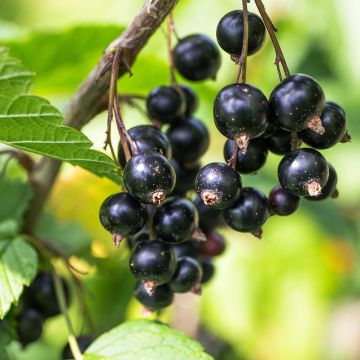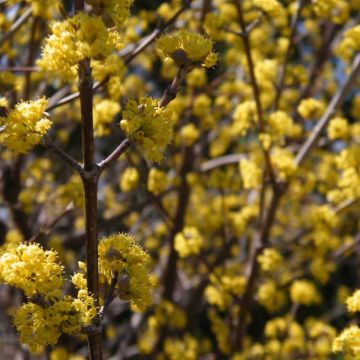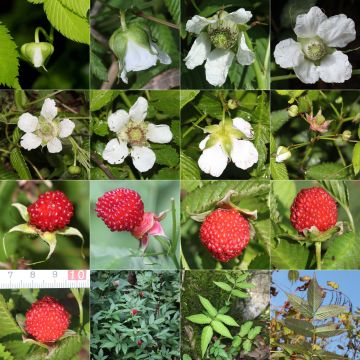

High Gourmet Hedge Kit - length 8/12m (26/39ft)
High Gourmet Hedge Kit - length 8/12m (26/39ft)
This plant carries a 6 months recovery warranty
More information
We guarantee the quality of our plants for a full growing cycle, and will replace at our expense any plant that fails to recover under normal climatic and planting conditions.
From €5.90 for pickup delivery and €6.90 for home delivery
Express home delivery from €8.90.
Collection items (4 plants)
-
Cornus mas Schönbrunner Gourmet Dirndl - European Cornel
Price per single item: €55.00Find out more
Description
We're offering you this tall edible fruit Hedge Kit, comprising four different fruit bushes, which will allow you to create a hedge measuring 8 to 12 meters (26 to 39 feet) long depending on the planting density. You will find Hazelnut and German Medlar, as well as an Alder-leaved Shadbush and a male Cornelian Cherry selected for their interesting fruiting. Plant them in autumn in any rich and deep, not too dry garden soil, unless the soil is clearly limestone. Good harvests can be expected after 4 years of cultivation, from June to October-November.
The Kit consists of:
- 1 x Common Hazelnut (Corylus avellana): a fast-growing bushy shrub, reaching 5 m (16 ft) in height by 4 m (13 ft) in spread, with deciduous foliage. The hazelnuts surrounded by green and indented bracts turn brown when ripe. Grouped in 1 to 4, they measure 2 cm (1in) in diameter. They can be harvested from late August on plants aged 3-4 years.
- 1 x German Medlar (Mespilus germanica): a deciduous shrub of medium growth with a wide habit, reaching 3 m (10 ft) in height and 4 m (13 ft) in spread. Its branches sometimes have a few large scattered thorns, and its large dark green leaves turn orange in autumn. It flowers in late May. The fruits, called medlars, measure 3 cm (1in) in diameter. Their reddish-brown skin hides a creamy, sweet flesh once over-ripe. They can be harvested after the first frosts, starting in October depending on the region.
- 1 x Saskatoon Berry Amelanchier alnifolia: a rather slow-growing deciduous shrub with a bushy habit, reaching 3 m (10 ft) in height and 2 m (7 ft) in spread. Its spring white flowering is followed by clusters of dark fruits with a complex and nutrient-rich taste that can be harvested from June to August and consumed in multiple ways. This Amelanchier quickly bears fruit around the age of 3-4 years. A single plant is sufficient to obtain a harvest ranging from 3 kg up to 7-8 kg of fruit depending on soil fertility, but it is often recommended to plant two shrubs to optimise fruit formation.
- 1 x Cornus mas (Cornelian Cherry) Schönbrunner Gourmet Dirndl' : an Austrian variety with large fruits. A deciduous shrub with an upright habit, reaching 4 m (13 ft) in height and 3 m (10 ft) in spread. Beautiful yellow flowers bloom on bare branches in February-March. The flowers visited by the first bees of the season give way to edible pear-shaped berries 3 cm (1in) long. They ripen and turn red from late August to September. Although this variety is self-fertile, it is advisable to plant at least two specimens to obtain satisfactory fruiting.
These small trees create a rural and welcoming atmosphere for small wildlife, decorative from spring to autumn, and interesting for the gourmet gardener. They can be planted at the boundary of a rural property, creating a pleasant transition to the countryside.
Plant these shrubs in full sun or partial shade, in well-prepared, preferably non-calcareous soil, mixing them and spacing them 2 m (7 ft) apart to cover 8 linear meters within 5 years. You can space them 3 m (10 ft) apart to form a 12-m (39 ft)-long hedge, but it will only become dense after 7 to 9 years. It is best to avoid pruning this natural hedge to avoid compromising flowering and fruiting. If you need to intervene, avoid doing so during nesting season. Proceed on a case-by-case basis, shortening the branches of shrubs that become too large. Water abundantly at planting and regularly until the end of the first summer if it does not rain. To save on watering, apply a mulch at the base of your shrubs.
Report an error about the product description
Plant habit
Fruit
Flowering
Foliage
Botanical data
Cultivar or hybrid
Other Fruit trees A to Z
Planting and care
Plant this kit in the sun or partial shade, in well-prepared and loosened, preferably slightly acidic to neutral soil (the serviceberry doesn't like limestone too much). They are adaptable to all regions except for the Mediterranean coast and high mountains. Very hardy, these bushes only require a one-off maintenance when young, namely a summer mulching to maintain some moisture to help them establish. You should water them the first year and possibly the second, only in case of marked drought. Once well established, they will manage on their own. You can prune the most vigorous bushes in autumn and winter. Always prune outside birds' nesting period (from March to June-July).
Planting period
Intended location
Care
This item has not been reviewed yet - be the first to leave a review about it.
Berries
Haven't found what you were looking for?
Hardiness is the lowest winter temperature a plant can endure without suffering serious damage or even dying. However, hardiness is affected by location (a sheltered area, such as a patio), protection (winter cover) and soil type (hardiness is improved by well-drained soil).

Photo Sharing Terms & Conditions
In order to encourage gardeners to interact and share their experiences, Promesse de fleurs offers various media enabling content to be uploaded onto its Site - in particular via the ‘Photo sharing’ module.
The User agrees to refrain from:
- Posting any content that is illegal, prejudicial, insulting, racist, inciteful to hatred, revisionist, contrary to public decency, that infringes on privacy or on the privacy rights of third parties, in particular the publicity rights of persons and goods, intellectual property rights, or the right to privacy.
- Submitting content on behalf of a third party;
- Impersonate the identity of a third party and/or publish any personal information about a third party;
In general, the User undertakes to refrain from any unethical behaviour.
All Content (in particular text, comments, files, images, photos, videos, creative works, etc.), which may be subject to property or intellectual property rights, image or other private rights, shall remain the property of the User, subject to the limited rights granted by the terms of the licence granted by Promesse de fleurs as stated below. Users are at liberty to publish or not to publish such Content on the Site, notably via the ‘Photo Sharing’ facility, and accept that this Content shall be made public and freely accessible, notably on the Internet.
Users further acknowledge, undertake to have ,and guarantee that they hold all necessary rights and permissions to publish such material on the Site, in particular with regard to the legislation in force pertaining to any privacy, property, intellectual property, image, or contractual rights, or rights of any other nature. By publishing such Content on the Site, Users acknowledge accepting full liability as publishers of the Content within the meaning of the law, and grant Promesse de fleurs, free of charge, an inclusive, worldwide licence for the said Content for the entire duration of its publication, including all reproduction, representation, up/downloading, displaying, performing, transmission, and storage rights.
Users also grant permission for their name to be linked to the Content and accept that this link may not always be made available.
By engaging in posting material, Users consent to their Content becoming automatically accessible on the Internet, in particular on other sites and/or blogs and/or web pages of the Promesse de fleurs site, including in particular social pages and the Promesse de fleurs catalogue.
Users may secure the removal of entrusted content free of charge by issuing a simple request via our contact form.
The flowering period indicated on our website applies to countries and regions located in USDA zone 8 (France, the United Kingdom, Ireland, the Netherlands, etc.)
It will vary according to where you live:
- In zones 9 to 10 (Italy, Spain, Greece, etc.), flowering will occur about 2 to 4 weeks earlier.
- In zones 6 to 7 (Germany, Poland, Slovenia, and lower mountainous regions), flowering will be delayed by 2 to 3 weeks.
- In zone 5 (Central Europe, Scandinavia), blooming will be delayed by 3 to 5 weeks.
In temperate climates, pruning of spring-flowering shrubs (forsythia, spireas, etc.) should be done just after flowering.
Pruning of summer-flowering shrubs (Indian Lilac, Perovskia, etc.) can be done in winter or spring.
In cold regions as well as with frost-sensitive plants, avoid pruning too early when severe frosts may still occur.
The planting period indicated on our website applies to countries and regions located in USDA zone 8 (France, United Kingdom, Ireland, Netherlands).
It will vary according to where you live:
- In Mediterranean zones (Marseille, Madrid, Milan, etc.), autumn and winter are the best planting periods.
- In continental zones (Strasbourg, Munich, Vienna, etc.), delay planting by 2 to 3 weeks in spring and bring it forward by 2 to 4 weeks in autumn.
- In mountainous regions (the Alps, Pyrenees, Carpathians, etc.), it is best to plant in late spring (May-June) or late summer (August-September).
The harvesting period indicated on our website applies to countries and regions in USDA zone 8 (France, England, Ireland, the Netherlands).
In colder areas (Scandinavia, Poland, Austria...) fruit and vegetable harvests are likely to be delayed by 3-4 weeks.
In warmer areas (Italy, Spain, Greece, etc.), harvesting will probably take place earlier, depending on weather conditions.
The sowing periods indicated on our website apply to countries and regions within USDA Zone 8 (France, UK, Ireland, Netherlands).
In colder areas (Scandinavia, Poland, Austria...), delay any outdoor sowing by 3-4 weeks, or sow under glass.
In warmer climes (Italy, Spain, Greece, etc.), bring outdoor sowing forward by a few weeks.



























































